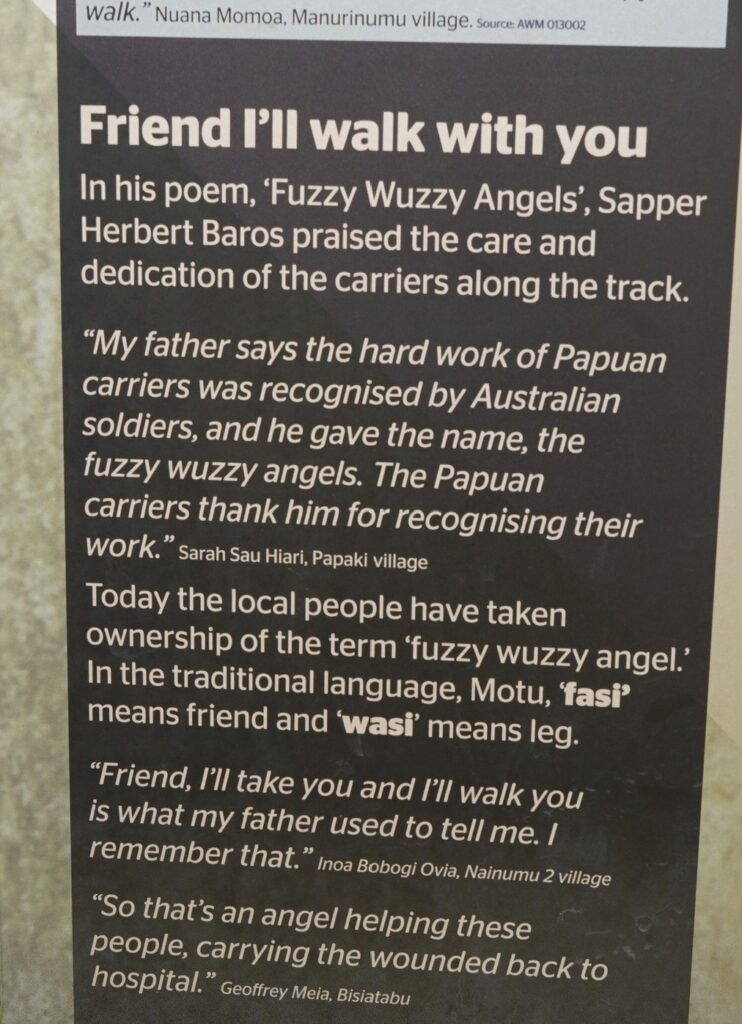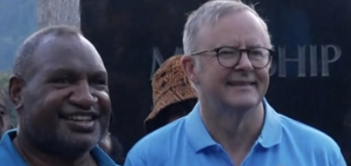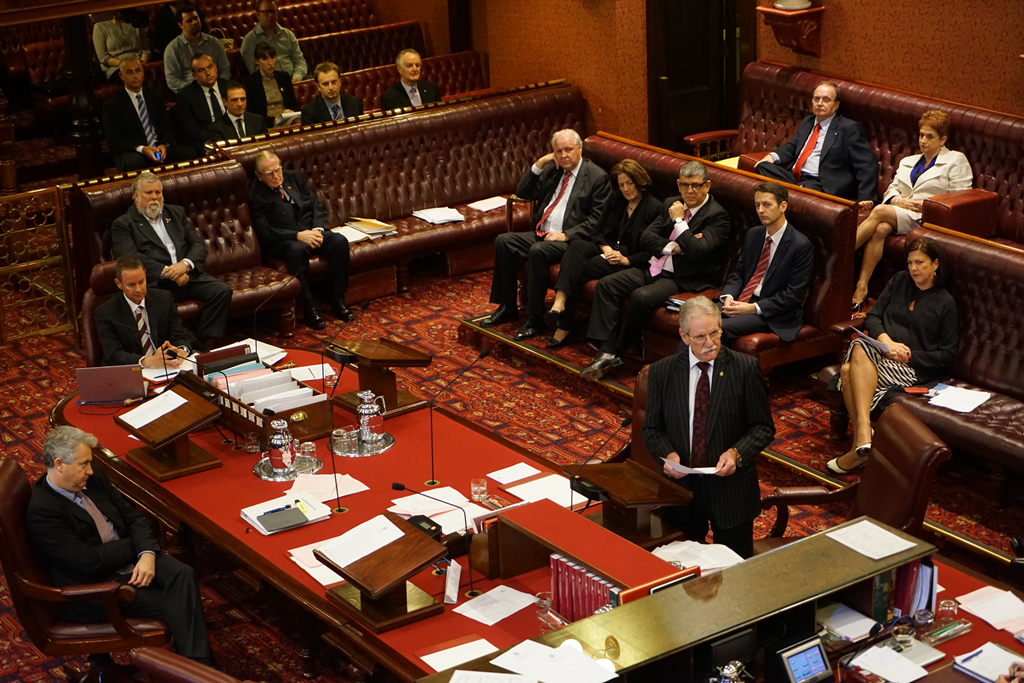The tender for the design, development and construction of the interpretative panels was awarded to ‘The Interpretative Design Company’ based in Coffs Harbour. According to their website the contract was ‘for the provision of interpretive services to the Australian Government Kokoda Initiative Taskforce’.
There is no record of this company having any previous experience or empathy with Papua New Guinea which is evident in their opening statement[i]:
‘With our first trip to PNG set for November 2015 and a deadline of ANZAC Day 2016 we had to hit the ground running.
‘Port Moresby is a confronting city and rated as one of the most violent places on the planet. It accosts the senses with its obvious social inequity. When the security agency describes recent events of rape and brutal assaults you cannot help but experience fear.’
This is a patronising insult to their host country and reflects an appalling level of ignorance about the progressive advancement of Port Moresby in recent years.
They also indicated that they have no knowledge of historical wartime interpretation:
‘Researching and writing for this project was both stimulating and challenging. As there was no clear objective, other than some signage at Owers’ Corner that would portray the WWII experiences of the people of PNG, we had to start from scratch in workshops and engaging with the local communities.’
If there was ‘no clear objective’ in the tender document, ‘other than some signage at Owers Corner’ then surely the bureaucrats who developed and approved the tender should be removed.
The statement that ‘we had to start from scratch in workshops with engaging the local communities’ beggars belief. The Australian War Memorial is the custodian of Australia’s wartime history. They should have been consulted to provide the research material required and to ensure that any such work was completed in accordance with the Principles of Commemoration.
The local community was not involved in the process. When I completed my Anzac trek at Owers Corner on 24 April 2016 I was approached by a local landowner who had a query about ‘somebody from the Kokoda Initiative coming to build something’ the following week. He was never consulted and knew nothing about it. I was unable to provide him with any information as we were also unaware of it.
It is worth noting that they missed their deadline of Anzac Day, 2016!
Kokoda: Reality Vs the Myth
According to The Interpretative Design Company website they consulted with key partners from both nations ‘to develop an interpretive display that presented the wartime experiences of the Papuan and New Guinean people’.
Surely if Australian taxpayers money is to be used on such projects they should tell our Australian story.
This is not the case in this politically correct endeavour.
The Interpretative Design Company advised on their website that:
‘other than some signage at Owers’ Corner that would portray the WWII experiences of the people of PNG, we had to start from scratch in workshops and engaging with the local communities.’
One can only wonder what an Australian soldier has to do to get a mention in the Canberra interpretation of the Kokoda campaign. Private Bruce Kingsbury was posthumously awarded the first Victoria Cross on Australian territory. Corporal Charlie McCallum was recommended for a Victoria Cross, received a Distinguished Conduct Medal and was killed in action at Brigade Hill – he does not rate a mention! Corporal John Metson was bayoneted to death after one of the most selfless acts of sacrifice in the Kokoda campaign – neither one rates a mention!
Nor do any of the other 623 men who were killed in action during the Kokoda campaign.
The facts behind the sacrifice of the Papua and New Guinea wartime carriers have also been omitted.
Without their support the Australians would have been defeated by the Japanese. However, to our eternal shame, these selfless heroes have never been recognised with an official medal or Roll of Honour. The skeletons of hundreds, perhaps thousands, lie in unmarked graves over the Owen Stanley Ranges. They have no name – no grave – no record of their sacrifice – and no spiritual resting place such as a traditional cenotaph.
There is no mention of this shameless omission on any of the panels.

Unsubstantiated Doggerel
The panel ‘Friend I’ll Walk With You’ is reminiscent of the hashtag ‘Friend I’ll Ride With You’ which was created by Australian appeasers during the terrorist attack on the Lindt Café in Sydney in December 2014.
The following description on the panel could only be described as unsubstantiated doggerel:
‘My father says the hard work of Papuan carriers was recognised by the Australian soldiers, and he gave the name, the fuzzy wuzzy angels. The Papuan carriers thank him for recognising their work’.
Sarah Sau Hiari, Papaki village: ‘Today the local people have taken ownership of the term ‘fuzzy wuzzy angel’.In the traditional language, Motu, ‘fasl’ means friend and ‘wasl’ means leg.
”Friend, I’ll take you and I’ll walk you is what my father used to tell me. I remember that.’ Inoa Bobogi Ovia, Nainumu 2 village’So that’s an angel helping those people carrying the wounded back to hospital.’ Geoffrey Mela, Bisiataby
Historical information on the reality of the service and sacrifice of the wartime carriers is readily available in books written by wartime journalists assigned to New Guinea during the Pacific War.
Incorrect Nomenclature
The information panels refer to ‘Kokoda Track’ rather than the official geographic name ‘Kokoda Trail’ gazetted by the Papua New Guinea Government on 12 October 1972 (PNG Government Gazette No. 88 of 12 October 1972, page 1362, Column 2. Notice 1972/28 of the PNG Place Names Committee refers).
The battle honour, ‘Kokoda Trail’ was awarded to the Papuan Infantry Battalion by the Commonwealth Battles Nomenclature Committee in 1958. There is no mention of this prestigious award on the information panels.
The use of the politically correct term ‘Kokoda Track’ is a patronising insult to the traditional owners of the land i.e. the National Government of Papua New Guinea and to their troops who fought in the Kokoda campaign. It is a denial of their sovereign right to name their own geographic features.
It is also worthy of note that soldiers on active service do not get ‘seriously injured or lose their lives’ – they are combat casualties who get killed or wounded and are officially recorded as KIA or WIA.
Historical Inaccuracies
Under a heading ‘Changes along the Track’ a panel records: ‘In 1942, the Kokoda Track became the site of bloody battles in which Papuans, New Guineans, Australians, Americans and Japanese were seriously injured or lost their lives.’
This is historically incorrect as there were no American units involved in the Kokoda campaign.
Under the heading ‘Green Shadows’ the panel records: ‘Members of the Papuan Infantry Battalion (PIB) were the first to resist the Japanese in the invasion of Papua.’
This is historically incorrect. The first unit to resist the Japanese invasion of Papua was the 2/22nd Battalion, known as Lark Force, at Rabaul on 23 January 1942.
Kokoda Initiative Propaganda
The panels advise ‘The Kokoda Initiative is a partnership between the Australian and PNG Governments to protect the environment, help develop local communities and maintain opportunities for tourism along the Kokoda Track.’
If this is true they have failed substantially in all three areas.
It goes on to state that the Kokoda Initiative ‘also seeks to honour the wartime significance of the region and to protect the natural and cultural heritage values while promoting sustainable tourism and trekking opportunities.’
This is misleading. Australian Department of Environment officials have been stationed in Port Moresby since 2008 with budgets exceeding $50 million. After eight years in-situ:
- not one of the five strategies or 33 objectives established by the Australian Department of Environment for the period 2012-2015 has been achieved;
- they have failed to develop a master plan to protect and interpret the wartime heritage of the Kokoda campaign;
- they have failed to develop the necessary legislation to support the authority of the management authority;
- they have failed to develop a campsite accreditation system;
- they have failed to develop a trek itinerary management system;
- they have failed to develop a campsite booking system;
- they have failed to develop a database – there is therefore no record of the 40,000 Australians who have trekked Kokoda over the past decade;
- they have failed to develop a mechanism for resolving local disputes- the dipute at the Isurava Memorial site is now entering its third year;
- they have failed to develop a mechanism for determining local needs for villagers – not a single village workshop has been conducted since 2008;
- they have failed to teach local villagers how to ‘value-add’ by providing goods and services that meet the needs of trekkers – there has not been a single outcome from the multi-million dollar ‘village livelihoods program’ initiated in Canberra without consultation with the PNG Department of Community Development;
- the website for the management authority is obsolete and irrelevant;
- the management organisation they put in place is now beyond dysfunctional;
- the trek ranger system they put in is virtually non-existent;
- the environmental condition of the trail continues to deteriorate because of the lack of a trail maintenance system;
- there is not a single acceptable ablution facility for female trekkers along the entire trail. The toilets facilities are appalling and are greeted with a disparaging ‘Aah Yuk’ by those who have to use them. Many now choose to ‘go bush’ rather than use them.
I can verify all of the above failures with a walk-through the current KTA office and a trek across the trail with any of Kokoda Initiative-KTA Ministerial/Departmental advisors.
I have been informally advised that the Kokoda Initiative plans to place more panels in villages along the trail. If this is true I would ask that the program be suspended until a proper master plan to protect and interpret the wartime historical integrity of the Kokoda Trail is completed by an accredited heritage architect. The Returned Services League of Australia, the Australian War Memorial and the National Museum of PNG should be involved in the development of any such plan.
We cannot, and will not, allow the Kokoda campaign to be reinterpreted through the prism of political correctness and we can no longer tolerate the Department of Environments resistance to the development of a master plan to protect and interpret the wartime history of the Kokoda Trail.
I therefore recommend that a Kokoda Advisory Committee be established with representatives from DFAT, DVA, DOE, the PNG Government, the Returned Service League and the Australian War Memorial to develop a Master Plan to honour the wartime history of the Kokoda campaign.
I would be willing to chair such a committee on a pro-bono basis.
Further Reading:
- Owers Corner – Neglected Gateway to the Kokoda Trail
- Case for a Visitors Centre at Owers Corner
- Owers Corner – The Road to Nowhere 80 years on!
- OWERS CORNER: How to convert a memorial junkyard into PNGs No 1 Tourism Asset

[i] http://interpretivedesign.com.au/interpretive/signage/historical-heritage/kokoda-track-war-history-signage/





